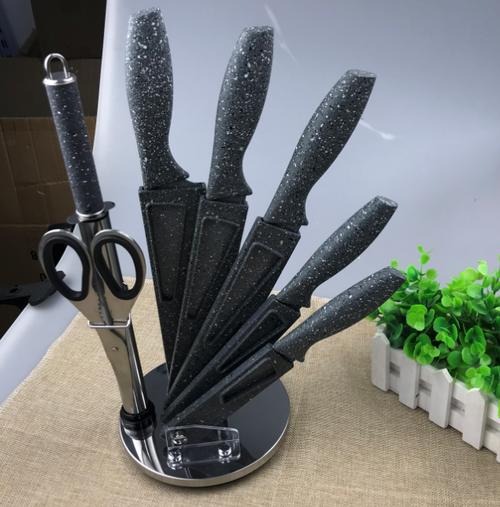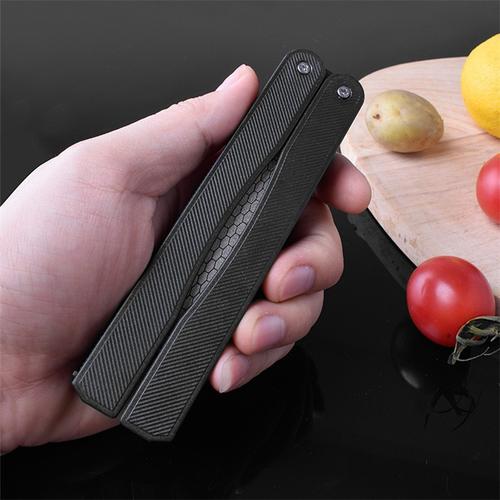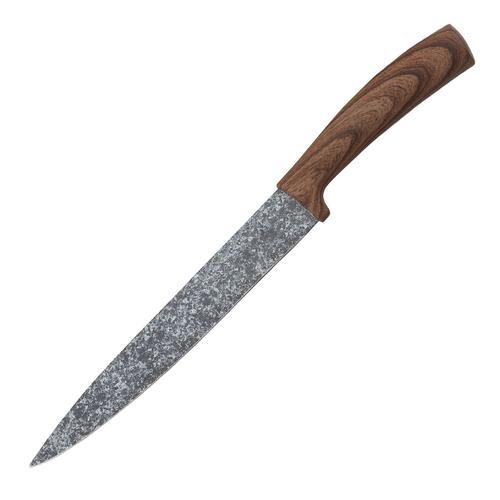

Views: 222 Author: Ella Publish Time: 2025-04-25 Origin: Site








Content Menu
● Understanding Kitchen Knife Blade Materials
>> 5. Ceramic
● How Blade Material Influences Knife Performance
● Choosing the Right Blade Material for Your Needs
>> For Professional or Enthusiast Chefs
>> For Specialty or Heavy-Duty Use
>> For Low Maintenance and Light Use
● Additional Factors to Consider
● FAQ: Kitchen Knife Blade Materials
>> 1. What is the difference between carbon steel and stainless steel knives?
>> 2. Are Damascus steel knives worth the extra cost?
>> 3. How do I maintain a carbon steel kitchen knife?
>> 4. Can I use ceramic knives for all kitchen tasks?
>> 5. What blade material is best for beginner cooks?
Choosing the right kitchen knife is essential for efficient, safe, and enjoyable cooking. One of the most important factors to consider when selecting a kitchen knife is the blade material. The blade material determines the knife's sharpness, durability, ease of maintenance, and overall performance. This comprehensive guide will help you understand the various blade materials, their advantages and disadvantages, and how to select the best kitchen knife based on your needs.

Kitchen knives are primarily made from different types of steel or other materials like ceramic. Each material has unique properties affecting the knife's sharpness, edge retention, corrosion resistance, and ease of sharpening.
Carbon steel is an alloy of iron and carbon, known for its ability to take a very sharp edge and ease of sharpening. It is highly durable and tough, making it suitable for heavy-duty kitchen tasks.
- Advantages: Sharpness, edge retention, ease of sharpening, toughness.
- Disadvantages: Prone to rust and corrosion if not properly maintained; requires regular care.
- Best for: Professional chefs and enthusiasts who value sharpness and are willing to maintain their knives carefully.
Carbon steel knives develop a protective patina over time, which helps prevent rust but requires proper care such as drying immediately after use and occasional oiling[2][13][20].
Stainless steel contains at least 10.5% chromium, which enhances corrosion resistance. It is the most common blade material for kitchen knives due to its low maintenance.
- Advantages: Rust-resistant, easy to maintain, durable.
- Disadvantages: Generally not as sharp or edge-retentive as carbon steel; harder to sharpen.
- Best for: Everyday home cooks who want a low-maintenance knife that resists stains and rust.
Common stainless steel types include VG-10, 440C, 420HC, and AUS-8, each with varying degrees of hardness and corrosion resistance[2][11][12].
Damascus steel blades are made by layering different types of steel, typically a hard carbon steel core wrapped in softer stainless steel layers. This results in a blade that combines sharpness with durability and corrosion resistance.
- Advantages: Unique aesthetic patterns, sharp edge, good balance of hardness and flexibility.
- Disadvantages: More expensive, requires some maintenance.
- Best for: Those seeking a high-performance knife with a distinctive look.
The layered construction also makes Damascus knives easier to sharpen and more resistant to damage[1][3][4][5].
Tool steels like D2, O1, and CPM series are very hard and wear-resistant, often used in knives designed for heavy use.
- Advantages: High hardness, excellent edge retention.
- Disadvantages: Less corrosion resistant, can be brittle.
- Best for: Knives used for demanding tasks requiring durability.
Ceramic knives are extremely sharp and rustproof but are brittle and prone to chipping.
- Advantages: Sharpness, no rust, lightweight.
- Disadvantages: Fragile, difficult to sharpen.
- Best for: Light cutting tasks and users who want minimal maintenance.

When choosing a kitchen knife, consider how the blade material affects these key performance factors:
- Sharpness and Edge Retention: Carbon steel and Damascus steel knives typically hold a sharper edge longer than stainless steel.
- Corrosion Resistance: Stainless steel excels in resisting rust and stains, while carbon steel requires more care.
- Ease of Sharpening: Carbon steel knives are easier to sharpen; stainless steel knives require more effort.
- Durability and Toughness: Tool steels and carbon steels are tougher but may be more prone to corrosion.
- Maintenance Needs: Stainless steel knives are low maintenance; carbon steel and Damascus knives require regular cleaning and drying.
- Recommended Material: Stainless steel (e.g., VG-10, 440C)
- Why: Low maintenance, rust-resistant, durable enough for most kitchen tasks.
- Example: Victorinox paring knives, many commercial chef's knives.
- Recommended Material: High-carbon steel or Damascus steel
- Why: Superior sharpness and edge retention, allowing precision cuts.
- Maintenance: Requires careful cleaning, drying, and occasional oiling to prevent rust.
- Example: Zwilling Kanren with high-carbon stainless core and Damascus cladding.
- Recommended Material: Tool steel or layered Damascus steel
- Why: High wear resistance and toughness for heavy chopping or boning.
- Example: CPM 3V steel knives or O1 tool steel knives.
- Recommended Material: Ceramic
- Why: No rust, very sharp, lightweight.
- Limitations: Fragile, not suitable for heavy chopping or twisting motions.
Blade geometry affects cutting performance alongside material. Western knives often have a double-bevel grind (20-30 degrees), suitable for durability and ambidextrous use. Japanese knives may have a sharper angle (12-18 degrees) and single bevel for precision but require more care[1].
The handle affects comfort and control. Common materials include wood (traditional, pleasant feel, but requires care), plastic (lightweight, moisture-resistant), metal (durable but heavier), and composite materials like Micarta (durable and excellent grip)[3].
Choosing a kitchen knife based on blade material depends on your cooking style, maintenance willingness, and budget. Carbon steel knives offer superior sharpness and edge retention but require diligent care to prevent rust. Stainless steel knives provide ease of maintenance and corrosion resistance, ideal for everyday use. Damascus steel combines the best of both worlds with unique aesthetics and balanced performance. Tool steels offer toughness for heavy-duty tasks, while ceramic knives suit light, low-maintenance cutting.
Understanding the properties of each blade material will help you select a knife that not only performs well but also fits your lifestyle and kitchen needs.

Carbon steel knives are sharper and easier to sharpen but prone to rust and require more maintenance. Stainless steel knives resist rust and stains better but usually don't hold an edge as long and can be harder to sharpen[2][12][13].
Yes, Damascus knives offer a unique combination of sharpness, durability, and aesthetic appeal due to their layered construction. They require some maintenance but provide excellent performance and a distinctive look[1][3][4].
To maintain carbon steel knives, hand wash immediately after use, dry thoroughly, apply a thin layer of oil to prevent rust, and store in a dry place. Over time, a patina forms that protects the blade from corrosion[13][14].
Ceramic knives are very sharp and rustproof but brittle. They are best used for slicing fruits, vegetables, and boneless meats. Avoid using them on hard or frozen foods, bones, or for prying tasks to prevent chipping[3][17].
Stainless steel knives are ideal for beginners due to their low maintenance and durability. They are less prone to damage and easier to care for compared to high-carbon steel or Damascus knives[12][20].
[1] https://sharpedgeshop.com/blogs/knives-101/how-to-choose-a-kitchen-knife
[2] https://knifeinformer.com/discovering-the-best-knife-steel/
[3] https://en.tyrolitlife.com/guide/knife-guide/knife-materials-and-their-advantages-and-disadvantages-at-a-glance/
[4] https://www.thecookingguild.com/blogs/news/best-chef-knives
[5] https://www.knivesfromjapan.co.uk/materials-guide-i22
[6] https://www.seriouseats.com/why-buy-carbon-steel-knives-best-kitchen-tools
[7] https://www.youtube.com/watch?v=m2CeQI-5aeA
[8] https://prudentreviews.com/types-of-kitchen-knives/
[9] https://www.youtube.com/watch?v=ooBG0Dvls8k
[10] https://dalstrong.com/blogs/news/a-comprehensive-guide-to-the-different-types-of-knife-steel
[11] https://www.kitchenkapers.com/pages/how-to-choose-kitchen-knives
[12] https://knife-depot.com/pages/the-complete-guide-to-buying-kitchen-knives
[13] https://sharpedgeshop.com/blogs/knives-101/guide-maintenance-of-kitchen-knives
[14] https://www.deerandoak.co.uk/blogs/news/essential-knife-care-tips-maintaining-your-blades
[15] https://madeincookware.com/blogs/types-of-kitchen-knives
[16] https://www.youtube.com/watch?v=Hgti2oAhDsU
[17] https://www.youtube.com/watch?v=yp8JYlNXP_Y
[18] https://www.reddit.com/r/chefknives/comments/x83ke2/what_are_the_best_steels_for_chef_knives/
[19] https://msicardcutlery.com/knife-making-steel-information-faq/
[20] https://dfackto.com/blogs/news/which-material-works-best-for-kitchen-knives
[21] https://www.kitchenknives.co.uk/know-how/blog/different-types-of-kitchen-knife/
[22] https://www.seriouseats.com/the-best-essential-knives
[23] https://www.napoleon.com/en/uk/barbecues/blog/know-your-knives-how-choose-best-kitchen-knife
[24] https://finoak.com/articles/types-of-kitchen-knives-materials
[25] https://www.seriouseats.com/why-buy-carbon-steel-knives-best-kitchen-tools
[26] https://salamanderstoves.com/how-can-you-tell-if-a-kitchen-knife-is-well-made/
[27] https://www.bladehq.com/blog/knife-steel-guide
[28] https://www.epicedge.com/shopcontent.asp?type=ChoosingAChefsKnife
[29] https://www.chefs-edge.com.au/blogs/knife-care/the-definitive-guide-to-japanese-knife-steels
[30] https://www.thewildestroad.com/blog/carbon-vs-stainless-steel-knives
[31] https://www.goodhousekeeping.com/uk/product-reviews/house-garden/g32205000/best-kitchen-knives/
[32] https://www.kcm-catering-equipment.co.uk/acatalog/Understanding_Kitchen_Knives.html
[33] https://www.knivesandtools.com/en/ct/steel-types-for-kitchen-knives.htm
[34] https://www.istockphoto.com/photos/steel-knife
[35] https://www.shutterstock.com/search/knife-blade
[36] https://www.istockphoto.com/photos/kitchen-knife-blade
[37] https://www.atkinson-art.co.uk/product-tag/chefs-knife/
[38] https://www.nisbets.co.uk/knowyourknivesinfographic
[39] https://www.gettyimages.co.uk/photos/kitchen-knife
[40] https://www.youtube.com/watch?v=LO35cdWL1MQ
[41] https://www.istockphoto.com/photos/types-of-kitchen-knives
[42] https://www.youtube.com/watch?v=0hjvEXfaR2E
[43] https://www.finedininglovers.com/explore/articles/chef-knives-explained-blades-edges-and-materials
[44] https://www.shutterstock.com/search/metal-knife
[45] https://elementknife.com/pages/common-questions-about-kitchen-knives
[46] https://www.keywood.com.tw/kitchen-knife-blade-steel-material-types.html
[47] https://www.thebambooguy.com/blogs/kitchen-knives/different-knife-blade-materials
[48] https://circulon.uk.com/blogs/the-culinary-circle/what-you-need-to-know-when-buying-kitchen-knives
[49] https://www.souschef.co.uk/blogs/the-bureau-of-taste/how-to-care-for-your-kitchen-knife
[50] https://www.napoleon.com/en/uk/barbecues/blog/know-your-knives-guide-kitchen-knife-maintenance
[51] https://dalstrong.com/blogs/news/a-comprehensive-guide-to-the-different-types-of-knife-steel
[52] https://www.divertimenti.co.uk/blogs/the-cookery-edit/common-knife-questions
[53] https://www.hartsofstur.com/blog/kitchen-knife-buying-guide/
[54] https://santokuknives.co.uk/blogs/blog/japanese-knife-care-complete-chef-knife-care-guide
[55] https://www.ikea.cn/cn/en/rooms/dining/how-to-care-for-your-knife-pub0fed03ff